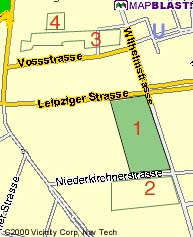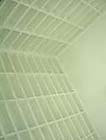 Sights Sights
 Medieval Remnants Medieval Remnants
 Prussian Glory Prussian Glory
 Nation to Republic Nation to Republic
 Nazi Germany Nazi Germany
 Divided City Divided City
 Modern Capital Modern Capital
 Tours Tours

|
Third Reich Government Quarter (Regierungsviertel)
Wilhelm Str. , 10117 Berlin - Mitte |
map:
From 1871, Wilhelm Strasse was Berlin's equivalent of London's
Downing St. and Whitehall. Many governmental departments and offices
lined the street, which runs from Unter den Linden (near the Pariser
Platz) in a SSEasterly direction into Kreuzberg. All but a few
were situated in the East German part of the city when the lines
were drawn. This area was the beating heart of the Third Reich
and where Hitler deemed it fit to build his new Chancellory
.
This map comes courtesy of Map Blast; clicking on the map takes
you to their web site. Numbers on the map correspond to the sites
described below.
- Bundesfinanzministerium (The Former Air Force Ministry - Reichsluftfahrtministerium)
Wilhelmstrasse 97, 10117 Berlin - Mitte
Built in 1935-36 from Sagebiel's design, this impressive building
on the corner of Wilhelm Str. and Leipziger Str. was Göring's
Air Force Ministry (Reichsluftfahrtministerium) until the end
of the war. It, somehow, survived the war and went on to be the
first home of the GDR government. After the government moved to
Schlossplatz, it was the home of the planning ministry until reunification,
when it was taken over by the German Finance Ministry and was
utilised by the Treuhand (the agency which sold off East German
property and companies). It is now the main building of the Finance
Ministry and looks as good as it did the day it was built.
- Site of Gestapo Headquarters
Niederkirchnerstr., 10117 - Mitte
A quick hop over the Berlin Wall from the Air Force Ministry is the site of the Gestapo Headquarters. After acquisitioning the building of the School of Applied Arts and Prinz Albrecht Hotel in 1933, the Gestapo used the building to carry out interrogations and torture of people suspected of being against the Nazis. Partly destroyed during the bombing, the structure was properly pulled down in the 1950's. Along the existing cellar wall is an outdoor exhibit called Topography of Terror which chronicles the Nazis' crimes during their reign of terror. Only the most insensitive could fail to feel the chill in the air.
- The site of the New Reichs Chancellory (Neue Reichskanzlei)
On practically the same site as the old Reichs Chancellory stood Hitler's huge, new version, designed by Albert Speer. Completed in 1938 after only eleven months, it was designed to impress with its long corridors and quarry-loads of red marble. None of the structure now exists after the Soviets tore it down and used some of the marble to make the war memorials on Strasse des 17. Juni and in Treptower Park . Some of the same marble can be seen in the nearby Mohrenstr. U-Bahnhof, where it was used to repair the walls.
- The site of Hitler's Bunker
Situated in the garden of the Old Chancellory, and nearby the new one, was Hitler's bunker. It was here where he spent the last weeks of his life (about six) sheltering from the Battle of Berlin above, trying in vain to win a war which was already lost. It was here, too, that he married Eva Braun and where, on 30th April 1945, he committed suicide. Soviet attempts to destroy the bunker after the war proved to be difficult as the 30cm concrete roof refused to be exploded. It was burnt and flooded and left unmarked until 1988 when the ceiling was destroyed and the whole thing was filled in.
|
Olympic Stadium (Olympiastadion)
Olympischer Platz 3, 14053 Berlin - Charlottenburg | Tel: 30 06 34 30 , Fax: no fax | U2 Olympia-Stadion (Ost), S5 Olympiastadion | Times: Hertha BSC home games. Entry at other times not permitted due to renovation. Open 2004.
map:
 Completed in 1936 for the Olympic Games, this Neoclassical structure was intended as a tool of Nazi propaganda and to play host to numerous Aryan victories. Sadly for Hitler, who didn't realise at the time that Europeans can't run very fast, the star of the games was Afro-American runner Jesse Owens who stole the show with four gold medals. One of the few Germans who could derive any satisfaction from the proceedings, apart from Hitler's bookmaker, was the stadium's designer, Werner March, who managed to create an incredibly impressive structure in which the seating falls away below ground level to create a much deeper auditorium than expected. Closed to visitors until 2004 for renovation, it is still possible to see inside by paying to watch Hertha BSC , the resident football team. Completed in 1936 for the Olympic Games, this Neoclassical structure was intended as a tool of Nazi propaganda and to play host to numerous Aryan victories. Sadly for Hitler, who didn't realise at the time that Europeans can't run very fast, the star of the games was Afro-American runner Jesse Owens who stole the show with four gold medals. One of the few Germans who could derive any satisfaction from the proceedings, apart from Hitler's bookmaker, was the stadium's designer, Werner March, who managed to create an incredibly impressive structure in which the seating falls away below ground level to create a much deeper auditorium than expected. Closed to visitors until 2004 for renovation, it is still possible to see inside by paying to watch Hertha BSC , the resident football team.
|
Tempelhof Airport
Columbiadamm 8, 10965 Berlin - Tempelhof | U6 Platz der Luftbrücke |
map:
At one time the central airport for the city, Tempelhof Airport used to be the largest building in Berlin. The first incarnation, which was the birthplace of Germany's main carrier, Lufthansa , was completed in 1923 but the recognisably Nazi structure by Ernst Sagebiel was constructed between 1936 and '41. Quite badly damaged during the war, the complex underwent further alterations and additions between 1959 and 1962. The decorative eagles are said to date back to the Weimar Republic and so survived the post war spring clean of all things associated with the Nazis. Used by the US military from the mid seventies until the nineties, it now operates only a few commercial flights and is supposed to be closed in the next few years when Schönefeld Airport is up and running properly. The airport's finest hour, however, was in 1948-49 during the Berlin Airlift when it received planes (as many as up to one a minute) bringing vital supplies to the blockaded western part of the city. The event is commemorated by the Luftbrückendenkmal (Airlift Memorial) which stands outside the airport on the Platz der Luftbrücke.
|
Former Reichsbank / Foreign Office - Auswärtiges Amt
Werderscher Markt , 10117 Berlin - Mitte | U2 Hausvogteiplatz, Bus 100, 157, 257, 348 |
map:
Standing on the grounds of the late 19th Century extension to the Royal Bank is Heinrich Wolff's former Reichsbank. The design was said to have been personally approved by Hitler with its strong right angles, powerful, sweeping lines and perfectly aligned windows. After being used after the war as the main seat of the Politburo and by the central committee of the Communist Party, it has been serving as part of the Foreign Office since the government's move from Bonn.
|
Bebel Platz
Unter den Linden , Berlin - Mitte | Bus 100 |
 Formerly known as Opernplatz, this square opposite Humboldt University was the brainchild of Friedrich II and architect Georg Wenzeslaus von Knobelsdorff and was to be the Forum Fridericianum, enclosed by a city palace, an academy and an opera house. Unfortunately, they didn't get round to finishing the job, only managing to build the opera house (Deutsche Staatsoper ) with Georg Christian Unger's Old Royal Library, opposite, being completed some 38 years later. The square made a name for itself on 10th May, 1933 when the Nazis held their first official book burning there, incinerating works of authors who were on the anti-Nazi "index". This event is remembered by the artwork in the centre of the square - a glass panel through which can be seen a room lined with empty, white bookshelves (left). If you step back a couple of metres, the impressive facades of the Humboldt University, Deutsche Staatsoper, and St Hedwig's Cathedral are reflected in the glass - a symbol of the oppression of free speech in this historic place of learning, culture and religion. The square was re-named in 1947 after the leader of the Social Democrats. Formerly known as Opernplatz, this square opposite Humboldt University was the brainchild of Friedrich II and architect Georg Wenzeslaus von Knobelsdorff and was to be the Forum Fridericianum, enclosed by a city palace, an academy and an opera house. Unfortunately, they didn't get round to finishing the job, only managing to build the opera house (Deutsche Staatsoper ) with Georg Christian Unger's Old Royal Library, opposite, being completed some 38 years later. The square made a name for itself on 10th May, 1933 when the Nazis held their first official book burning there, incinerating works of authors who were on the anti-Nazi "index". This event is remembered by the artwork in the centre of the square - a glass panel through which can be seen a room lined with empty, white bookshelves (left). If you step back a couple of metres, the impressive facades of the Humboldt University, Deutsche Staatsoper, and St Hedwig's Cathedral are reflected in the glass - a symbol of the oppression of free speech in this historic place of learning, culture and religion. The square was re-named in 1947 after the leader of the Social Democrats.
|
Sachsenhausen
Straße der Nationen 22, 16515 Oranienburg | Tel: 03301 20 00 (switchboard), 03301 20 02 00 (visitor information)., Fax: no fax | S1 Oranienburg, RB from Berlin-Charlottenburg (1 hour), RE from Berlin-Lichtenberg (30 mins). 20 mins signposted walk from the station, or take bus 804 or 805 to the corner of Bernauer Str and Straße der Einheit. | Price: Free. | Times: Tue-Sun 8:30-16:00.
map:
About 35km north of Berlin, which means of course that the inhabitants
of the capital ostensibly "knew nothing about it", is the
former concentration camp of Sachsenhausen. The camp took on the first
enemies of the state (mostly political opponents of the government)
in 1936, one month before the Swastika-waving frenzy of the Berlin
Olympic Games. Jews, Gypsies, homosexuals and other 'antisocial' types
quickly followed. A total of over 220,000 men were interned here before
1945; almost half of them never left. The memorial and museum which
were opened on this site in 1961 were designed to display the horrors
of fascism - it is only since reunification that Sachsenhausen's post-war
role as the Communist 'Special Camp 7' has also been recognised. Between
1945 and 1950 another 60,000 prisoners with incorrect ideologies passed
through the gates. Over 10,000 of them lie in mass graves nearby.
Several of the former buildings are still in place, and contain a
museum which has very good displays on the camp's history and on the
history of anti-Semitism. Memorials to the victims of Nazi and communist
mass-murder are scattered around the site. Overall a grim but informative
reminder of the nasty side of German history.
|

 top of page top of page
 ©
1999-2011 Berlin Information Group ©
1999-2011 Berlin Information Group anything missing or wrong? anything missing or wrong?
|

|